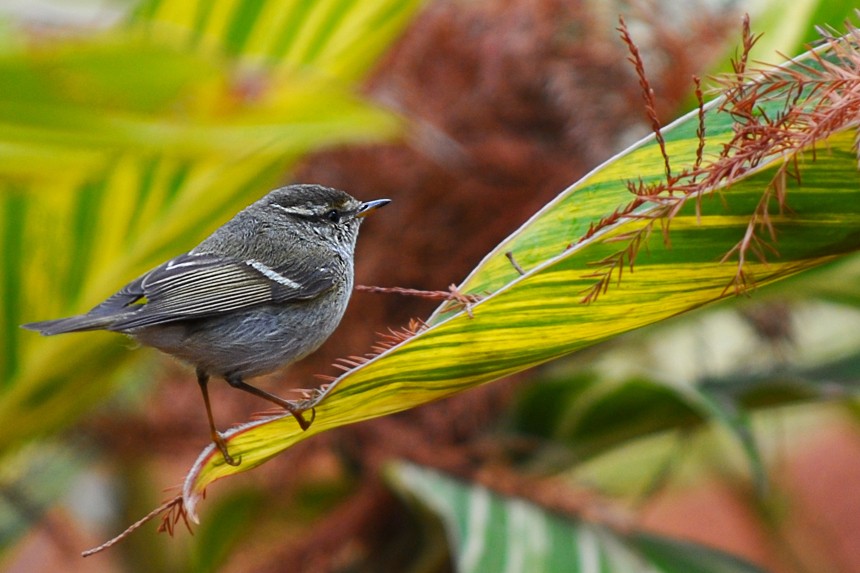Yellow-browed Warbler
A species of Chiffchaffs And Allies Scientific name : Phylloscopus inornatus Genus : Chiffchaffs And Allies
Yellow-browed Warbler, A species of Chiffchaffs And Allies
Botanical name: Phylloscopus inornatus
Genus: Chiffchaffs And Allies
Content
Description People often ask General Info
 Photo By E.HOBA , used under CC-BY-SA-2.0 /Cropped and compressed from original
Photo By E.HOBA , used under CC-BY-SA-2.0 /Cropped and compressed from original Description
This is one of the smaller Old World warblers, at 9.5–11 cm long and weighing 4–9 g distinctly smaller than a chiffchaff but slightly larger than Pallas's leaf warbler. Like many other leaf warblers, it has overall greenish upperparts and white underparts. It also has prominent double wing bars formed by yellowish-white tips to the wing covert feathers (a long bar on the greater coverts and a short bar on the median coverts), yellow-margined tertial feathers, and long yellow supercilium. Some individuals also have a faint paler green central crown stripe though many do not show this. It is not shy, but its arboreal life style makes it difficult to observe. It is almost constantly in motion. Its song is a high pitched medley of whistles; the call is piercing, often disyllabic "tseeweest", strikingly loud for the bird's small size. The only real possibility of confusion is with the similar-looking Hume's leaf warbler (P. humei), which in the limited area of overlap has duller colours, a faint second wing bar and dark legs and lower mandible. Their songs and calls are clearly distinct, with Hume's having a more chirping "chwee" call. It can easily be distinguished from Pallas's warbler as it does not have the a conspicuous yellow central crown stripe and rump patch shown by that species. 
Size
11 cm
Colors
Black
Green
Yellow
Gray
White
Life Expectancy
7 years
Nest Placement
Shrub
Feeding Habits
Yellow-browed Warbler, an insectivorous bird, primarily consumes insects, which it actively forages for in foliage. Its diet includes a variety of small arthropods, caterpillars, and larvae. Yellow-browed Warbler exhibits unique adaptability by utilizing different foraging techniques, often gleaning from leaves and bark.
Habitat
The yellow-browed Warbler finds its home primarily in lowland and montane forests, often preferring the base of trees or dense underbrush for nesting. Its breeding habitats include broadleaf woodlands and conifer forest edges, whereas mixed forests provide additional living space. Post-breeding, they may venture above the treeline into shrubs. In winter, yellow-browed Warbler adapts to a range of spaces from gardens to mangroves, across elevations up to 1,525 meters in areas from eastern Europe to the Malay Peninsula.
Dite type
Insectivorous
People often ask
General Info
Feeding Habits
Bird food type
Bird Feeder Type

Small Tube Feeder

Platform
Sounds
Call
Recording location: Belgium
Distribution Area
Like most warblers, it is insectivorous. The nest is built in dense vegetation often at the base of a tree or old stump; two to four (occasionally more) eggs are laid, hatching after 11–14 days, with the chicks fledging when 12–13 days old. This is an abundant bird of lowland and montane forests and woodlands; particularly in winter it may also be found in more open woods. Its breeding range extends from just west of the Ural Mountains eastwards to eastern Siberia, Mongolia and Northeast China. Its winter habitat is lowland broadleaf or coniferous forest, from West Bengal and Assam in northeastern India east through southern China to Taiwan, and through Bangladesh south to the Malay Peninsula. In summer, it occurs at altitudes of up to 2,440 m, and in winter, up to 1,525 m. The European breeding population west of the Urals has increased westwards in recent decades; in 1950 it was described as 'fairly scarce', but 'locally abundant' with 45,000–46,000 pairs in 1990. Small numbers, most likely from the western end of the breeding range, regularly winter in western Europe. These arrive in Great Britain in late September and October after a 3,000–3,500 km migration from the Urals, a markedly shorter distance than the 5,500–6,000 km they would need to fly to reach the normal wintering areas in southeastern Asia. Exact numbers in this population are unknown, but typically several hundred are found arriving in Great Britain each autumn; given their unobtrusive behaviour, this is probably only a fraction of the total. In the past widely considered to be vagrants, these birds are now thought to be undertaking a normal regular migration, able to take advantage of the mild oceanic climate winters on the western fringes of Europe for wintering. A common species in most of its wide range, the yellow-browed warbler is not considered threatened by the IUCN. Hume's leaf warbler overlaps its breeding range with yellow-browed warbler in the western Sayan Mountains, but the species apparently do not hybridise. Their lineages diverged roughly 2.5 million years ago. 
Species Status
Not globally threatened.
Scientific Classification
Phylum
Chordates Class
Birds Order
Perching birds Family
Phylloscopidae Genus
Chiffchaffs And Allies Species
Yellow-browed Warbler